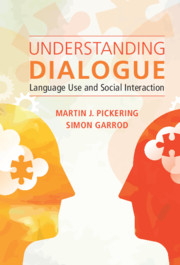Book contents
- Understanding Dialogue
- Understanding Dialogue
- Copyright page
- Contents
- Figures
- Tables
- Glossary
- Preface to Understanding Dialogue: Language Use and Social Interaction (Pickering & Garrod)
- 1 The Challenge of Dialogue
- Part I The Shared Workspace Framework
- Part II Alignment during Dialogue
- Part III Using the Shared Workspace Efficiently
- Part IV Extending the Shared Workspace Framework
- References
- Index
1 - The Challenge of Dialogue
Published online by Cambridge University Press: 11 February 2021
- Understanding Dialogue
- Understanding Dialogue
- Copyright page
- Contents
- Figures
- Tables
- Glossary
- Preface to Understanding Dialogue: Language Use and Social Interaction (Pickering & Garrod)
- 1 The Challenge of Dialogue
- Part I The Shared Workspace Framework
- Part II Alignment during Dialogue
- Part III Using the Shared Workspace Efficiently
- Part IV Extending the Shared Workspace Framework
- References
- Index
Summary
The chapter introduces the shared workspace framework for dialogue and other cooperative joint activities.
- Type
- Chapter
- Information
- Understanding DialogueLanguage Use and Social Interaction, pp. 1 - 8Publisher: Cambridge University PressPrint publication year: 2021

